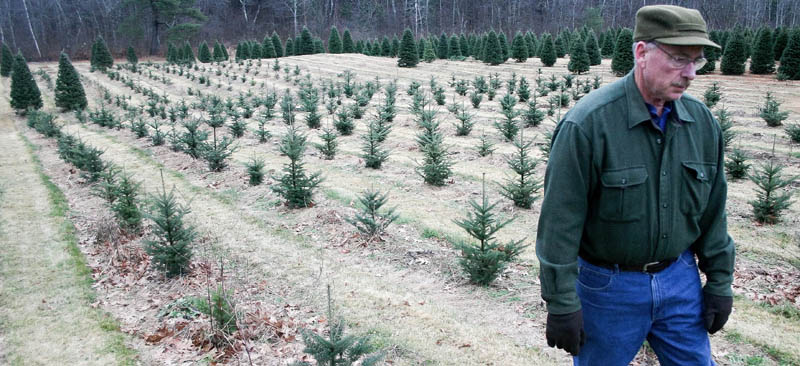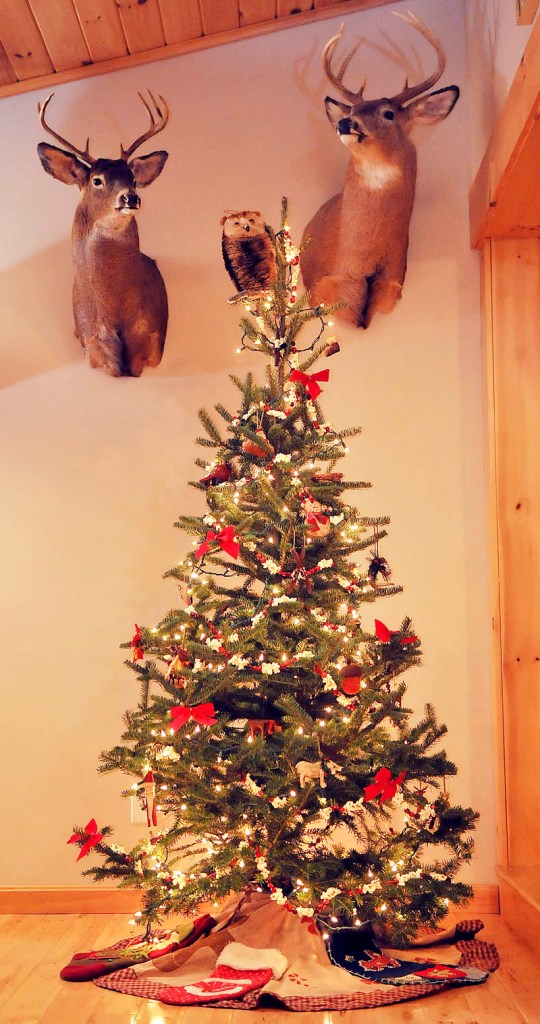As the old song goes, Christmas trees are green when summer days are bright; they’re green when winter snow is white.
They’re also green in an environmental sense.
Throughout Maine, more than 1.2 million Christmas trees are growing quietly on about 300 plots of land. Each tree will progress slowly from seed to seedling, from youth to maturity, until they’re harvested 12 years later for their brief moment of glory in living rooms and parlors throughout the land.
During that slow, silent journey, the trees will provide habitat for birds and insects and they will absorb carbon dioxide from the air and deliver it into the soil. And, increasingly, Christmas trees are finding a second life in Maine communities as mulch in parks and playgrounds or as biomass fuel.
This is the life of a Maine Christmas tree.
Humble beginnings
About half of all Maine’s Christmas trees begin at the same place, in the western Maine town of Fryeburg.
Since 1917, Western Maine Forest Nurseries have raised conifer trees from seed. The company grows about 500,000 seedlings every year, some of which are sold for reforestation projects and private landscaping, “but a good chunk of them stay right here in Maine for Christmas tree production,” said Rick Eastman, 57, the nursery’s third-generation owner.
For the past 30 years, Eastman has worked to breed the perfect Christmas tree. His nursery is the exclusive supplier to 145 members of the Maine Christmas Tree Association, who have funded an ongoing 30-year study to produce the best possible Christmas trees — hardy, fast-growing, insect- and disease-resistant balsam fir.
The effort is meant to save costs for growers. On average, growers invest about $1.50 per tree every year. On a mid-sized farm of 6,000 trees, that investment could top $9,000 a year.
“So, obviously, one of the goals was to shorten up the growing cycle if we could,” he said. “We’ve been successful at doing that.”
From seed to seedling, the Christmas trees stay at the nursery for two to five years, before they are shipped to growers, where they will stay for another eight to 10 years.
“When you buy a 7- to 8-foot Christmas tree, it is generally 12 to 15 years old. A lot of time, effort and money has been put into raising that tree,” Eastman said. “When someone goes to spend $46 on a tree they might say, ‘Boy, that seems like a lot of money.’ But some people have put 12 years of their life into that tree.”
Life on the farm
On an overcast day in early December, Dick Bradbury stood among his youngest crop of firs and lamented the Christmas tree business. It’s hard work, he said.
“Everybody thinks you just throw them in the ground then stand there and take the money in the fall,” he said, smiling. “I can’t tell you how many people think that and it upsets every grower I know.”
Bradbury, 57, has been growing Christmas trees at his South China home for almost 30 years, and he looked the part as he strolled between rows of balsam fir wearing a forest-green wool shirt and cap that perfectly matched his coniferous surroundings.
Bradbury got into the trade by accident, he said, as a natural extension of his earlier career for the Maine Forest Service.
In 1983, Bradbury — a master’s-level entomologist — began planting trees on his five-acre lot as a way to research insect management for the Christmas tree industry.
Bradbury’s research farm eventually grew into Bradbury’s Christmas trees — a cut-your-own farm with about 6,000 trees, ranging in years from two to 10.
“I just kept planting,” he said. “It kind of gets in your blood after a while.”
Bradbury does all the work himself. Every year in April, he plants between 500 and 1,000 of Eastman’s seedlings by hand.
“It’s hard work, but when you’re done, you’ve got an instant forest,” he said.
There’s other work, too. Twice a year, in spring and late summer, Bradbury applies more than a ton of fertilizer to the tree bases. He also applies herbicide around young trees because grass can overwhelm and kill them. In May, he typically sprays for bugs, particularly the balsam twig aphid. He also mows between the rows about 10 times a year during the growing months.
When the trees grow to be about elbow high they need to be sheared once a year until their sold. Bradbury, using a folding knife, can shear at a rate of one tree per minute. It may sound like a speedy job, but the time adds up quickly. He’ll work about four hours a day for more than a month to work through the entire farm — from the Fourth of July until the second week in August, he said.
“I used to do about 800 a day, but I’m petering out. I’m old,” he said.
Between Thanksgiving and Christmas each year, Bradbury opens his farm for business on Fridays, Saturdays and Sundays. During that time, he’ll sell about 500 trees at $35 each, for a grand total of about $17,500.
“I’ve got about 12 to 15 days to sell everything I’ve worked all year on,” he said.
Bradbury is planning to plant one more crop next spring and ease out of the business as slowly as he entered.
“By the time I’m 68, hopefully they’ll all be gone,” he said.
Artificial vs. real?
On a recent Sunday, newlyweds Ashley Hamilton-Ellis and Pat Ellis strolled Bradbury’s farm searching for the perfect tree. About 20 minutes later, they found it and sawed it down.
Hamilton-Ellis said she would never consider an artificial one.
“Never. No. Never ever, ever,” she said. “I’m anti-artificial Christmas tree. They ruin the Christmas spirit.”
The couple has been cutting their own trees at the farm the last four years. Cutting a tree themselves is a holiday tradition on par with tinsel, turkey or mistletoe.
“We like getting out and cutting your own. It just seems more real,” said Ellis.
Real trees are also more environmentally sound that artificial ones, said Jean English, editor of the Maine Organic Farmer & Gardener newspaper, who also holds master’s and doctorate degrees in plant and soil sciences.
In Lincolnville, English and her husband plant between 200 and 400 trees annually at a cut-your-own farm, which she described as a small, organic operation. The fir trees provide homes for wildlife and they help absorb greenhouse gases responsible for global climate change, she said.
“Real Christmas trees sequester carbon while they’re growing,” she said. “The ground they’re growing in keeps building up organic matter, which also helps keep carbon out of the atmosphere and in the soil.”
Also, nearly all Christmas tree growers plant a new tree for every one that is cut down, so sequestration continues long after the holidays, she said.
Artificial trees, on the other hand, cannot be recycled whenever their usable life ends, plus a lot of fossil fuels are burned to create and ship them to the U.S, she said.
When trees are cut and decompose, they release their stored carbon dioxide back to the atmosphere. However, many Maine towns now reuse the trees in ways that lessen the carbon release.
In Portland, for instance, the city collects about 20,000 Christmas trees every year, which are either burned for energy or chipped for mulch, according to the city’s environmental programs manager.
The mulch, which is later spread on the ground, slowly decomposes. The organisms that decompose the mulch will absorb some of the carbon, English said.
In Waterville, city officials have found a second life for about 500 of the 5,000 Christmas trees the city collects each year. Matt Skehan, director of Waterville’s Parks and Recreation Department, said the trees are arranged into a maze, like a hedge maze or corn maze, for the city’s annual Winter Carnival. Afterward, they’re burned.
The 4,500 remaining trees, however, are fed through a wood chipper in the spring and the mulch is spread through parks and playgrounds, which is a relatively new practice for Waterville, according to Public Works director Mark Turner.
“Within the past 10 years, we’ve become more recycling-conscious,” he said.
Ben McCanna — 861-9239
bmccanna@centralmaine.com
Send questions/comments to the editors.





